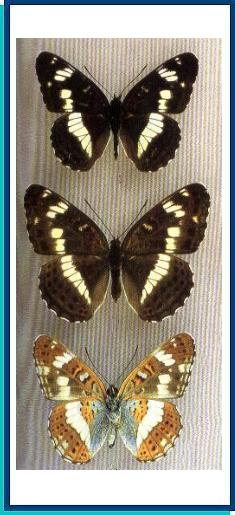LEPIDOPTERA
N Y M P H A L I D A E Swainson, 1827
LIMENITIS Fabricius, 1807
Limenitis camilla Linnaeus, 1764
Limenitis camilla Linnaeus, 1764

•TYPE LOCALITY. Germany.
•SYNONYMS: populi (Poda, 1761), nom. praeoccup.; prorsa (Linnaeus, 1764), nom. praeoccup.; sibylla (Hufnagel, 1766); sibilla (Linnaeus, 1767), nom. praeoccup.; luctuosus (Fourcroy, 1785); xylostei (Prunner, 1798); puellula Fruhstorfer, 1909; francottiana Hecq, 1990.
• RANGE. Temperate belt of the Palaearctic Region except for Siberia, the Caucasus and Transcaucasia, the Armenian Highland; the Amur and Ussuri regions, Sakhalin, Kunashir; NE. China, Korea, Japan.
• DISTRIBUTION AND VARIATION. The nominotypical subspecies inhabits the western part of the range (European part, Caucasus and Transcaucasia). Individual variability is great, reason for the description of a lot of infrasubspecific categories. In the Amur and Ussuri regions, the spp. Japonica Menetries, 1857 (= angustata Staudinger, 1887) is known to occur, which is distinguished by the rather small size (45-50 mm) and the narrower (almost twice) band on the UPH.
• HABITATS AND BIOLOGY. Occurring locally in deciduous forest with honeysuckle undergrowth, in gardens and parks. Flight period: June to July. Egg-laying solitarily on the upper surface of the leaf. Host plant in central Russia (Dantchenko & Nikolaevsky, in press): Lonicera xylosteum; in the S. Urals (Migranov, 1991);Lonicera tatarica, L. xylosteum; in the Ussuri region (Kurentzov, 1970): Lonicera maackii, L. gibbtflora. Instar 3 larvae hibernating in shelters built of rolled tube-shaped leaves fastened to twigs.
• SIMILAR SPECIES. Limenitis reducta: with one row of black submarginal spots on UNH. L. amphyssa, L. doerriesi, L. helmanni, L. homeyeri: with two white spots in central cell of UPF. L. sidyi: medial bands of UPS broad; spot in cell 2 on UPF shifted toward margin in relation to spot in cell 1.
Photo and text: Guide to the BUTTERFLIES OF RUSSIA and adjacent territories Volume 2. PENSOFT, Sofia - Moscow. 2000